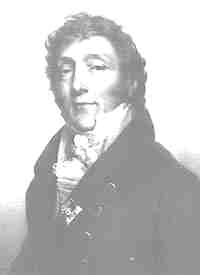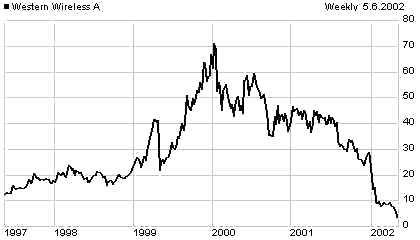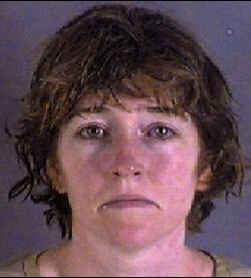Condamnés
à mort par la Révolution: ^top^
1794 (21 floréal an II):
BRIEN
Pierre, chaudronnier, domicilié aux Herbiers, canton de Montaigu
(Vendée), comme brigand de la Vendée, par la commission militaire
séante à Granville.
DESPREZ Nicolas Louis,
ex curé, domicilié à Sompuis (Marne), comme réfractaire à la loi ,
par le tribunal criminel dudit département.
RENARD Jean
Baptiste, voiturier, domicilié à Ecques (Nord), comme espion,
par la commission militaire de l’armée du Nord.
THEUREL
Augustin, domicilié à Charmes-St-Valber (Haute-Saône), par
le tribunal criminel dudit département, comme concussionnaire.
Par le tribunal révolutionnaire
séant à Cambray (Nord):
DHENNEVILLE Marie Eugénie, veuve Monaldy, 88 ans,
rentière, ex noble, domiciliée à Cambray, comme ayant provoqué l'anéantissement
de la liberté, et de la représentation nationale.
DUPUIS
Angélique, femme Dechy, marchande de fil, domiciliée à Cambray
, comme ayant conservé les bustes de Capet
et de sa
femme, et pour avoir gardé une petite pierre d'autel, dont son
fils se servait pour broyer des couleurs.
EVRARD Jean
Népomucène, chef du premier bataillon de l'Oise, comme traître
à la patrie.
GILLES Antoine, 72 ans, ci-devant
procureur à Arras (Nord), comme ayant provoqué l'anéantissement de
la liberté et de la Représentation nationale.
VIENNET
Aubert, rentier, domicilié à Cambray (Nord), comme traître
à la patrie, prévenu d'avoir discrédité les assignats.
A
Arras:
SIMON Noël, âgé de 29 ans, né à Villers le Sec, célibataire,
laboureur, déserteur.
CALLAU Rémy Joseph Omer,
né à Plouvain, cultivateur, époux de Saudemont Marie Anne Scholastque,
guillotiné.
LOCTEMBERG Eugénie, âgé de 33 ans,
née à Aire, demeurant à Racquinghem, veuve de Laforge N., guillotiné.
Par le tribunal révolutionnaire
de Paris:
CAPET Elizabeth Phil. Marie Hélène, 30 ans, sœur
du dernier tyran roi, née et domiciliée à Paris, comme complice de
son frère et sa belle sœur.
DUWAES Anne, 55
ans, veuve de l'Aigle, ex marquise née à Keiniltz en Westphalie, domicilié
à Montagne-de-Bel-Air, ci-devant St. Germain-en-Laye (Seine et Oise),
comme complice des complots formé par Capet et sa femme.
FOLLOPPE
Georges, 64 ans, né à Oucalix, près Yverot (Seine Inférieure),
pharmacien, officier municipal de Paris, domicilié à Paris, comme
complice des complots formés par Capet, sa femme et sa famille.
 TANEFFE
Françoise Gabrielle, veuve Montmorin, âgée de 50 ans, native
de Chadieu (Puy-de-Dôme, domiciliée à Bussy (Yonne),comme complice
de son mari, ayant entretenu des correspondances avec Laluzerne. —
MONTMORIN-SAINT-HÉREM Armand Marc (comte de) [portrait >]
Homme politique français, né à Paris en 1745, décédé à Paris en 1792.
Ambassadeur à Madrid de 1778 à 1784, puis gouverneur de Bretagne,
il fut nommé ministre des Affaires étrangères peu avant la Révolution
de 1789. Il conserva ces fonctions jusqu’en 1791, tentant de s’entremettre
entre la cour et Mirabeau.
N’ayant pas réussi à empêcher la déclaration de Pillnitz en 1791,
il fut accusé de faire partie du comité autrichien. Emprisonné à la
prison de l’Abbaye, il y fut tué lors des massacres de septembre 1792. TANEFFE
Françoise Gabrielle, veuve Montmorin, âgée de 50 ans, native
de Chadieu (Puy-de-Dôme, domiciliée à Bussy (Yonne),comme complice
de son mari, ayant entretenu des correspondances avec Laluzerne. —
MONTMORIN-SAINT-HÉREM Armand Marc (comte de) [portrait >]
Homme politique français, né à Paris en 1745, décédé à Paris en 1792.
Ambassadeur à Madrid de 1778 à 1784, puis gouverneur de Bretagne,
il fut nommé ministre des Affaires étrangères peu avant la Révolution
de 1789. Il conserva ces fonctions jusqu’en 1791, tentant de s’entremettre
entre la cour et Mirabeau.
N’ayant pas réussi à empêcher la déclaration de Pillnitz en 1791,
il fut accusé de faire partie du comité autrichien. Emprisonné à la
prison de l’Abbaye, il y fut tué lors des massacres de septembre 1792.
... comme
conspirateurs:
MONTMORIN Antoine Hugues Galixt, ex noble, sous lieutenant,
dans le régiment des chasseurs à cheval, âgé de 22 ans, natif de Versailles
(Seine et Oise), domicilié à Passy (Seine).
BERSIN CL.
L. Angélique (dite Dambaye), ex marquise, domiciliée à Paris.
BUARD Denise, vivant de son bien, domicilié à Paris.
LAMOIGNON Anne Nicolas, veuve Serozan, ex marquise,
âgée de 76 ans, née et domiciliée à Paris.
LETELLIER
Louis Pierre Marcel (dit Bullier), ci-devant employé à l'habillement
des troupes, ex noble, âgé de 22 ans, né et domicilié à Paris.
LENEUF-SOURDEVAL Louis Bernardin, ex comte, 69 ans,
né à Caen (Calvados), domicilié à Chatou (Seine et Oise).
LOMENIE
Alexis François, 36 ans, ex comte, ci-devant colonel des
chasseurs de Champagne, né à Marseille (Bouches du Rhône), domicilié
à Brienne (Aube).
LOMENIE Louis Marie Athanase,
64 ans, ex noble, ex ministre de la guerre, et maire de Brienne, né
à Paris, domicilié à Brienne (Aube).
LOMENIE Charles,
33 ans, ex chevalier de St Louis et de l'ordre de Cincinnatus, né
à Marseille (Bouches du Rhône), domicilié à Brienne (Aube).
LOMENIE Anne Marie Charlotte, 29 ans, femme divorcée
de Canizi, née et domiciliée à Paris.
LOMENIE Martial,
30 ans, ex noble coadjuteur de l'évêque du département de
l'Yonne, ci-devant archevêque de Sens, né à Marseille (Bouches du
Rhône), domicilié à Sens (Yonne).
MEGRET-D'ETIGNY
Antoine Jean Marie, 46 ans, ex sous aide major du régiment
des Gardes-françaises, ex noble, né à Paris, domicilié à Sens (Yonne).
DUBOIS Jean Baptiste, 41 ans, né à Merey (Marne,
domestique de Mégret d'Etigny, domicilié à Sens (Yonne).
MEGRET-SERILLY
Antoine Jean François, trésorier général de la guerre, ex
noble, âgé de 48 ans, natif de Paris, domicilié à Passy (Yonne).
LHOSTE Jean Baptiste, 47 ans, né à Forges (Oise),
agent et domestique de Megret Serilly, domicilié à Paris.
ROSSEL
Marie Anne Catherine, 44 ans, femme de Rosset Cery, officier
de marine, native de Rochefort (Charente), domicilié à Sens (Yonne),
comme conspiratrice ayant entretenue des émigrés.
L'HERMITE
Louis Claude (dit Chambertand), ex noble, ex chanoine en
la ci-devant cathédrale de Sens, âgé de 60 ans, né et domicilié à
Sens (Yonne).
L'HERMITE Elisabeth Jacques,
ex comtesse, 65 ans, femme de Rosset, ex comte, lieutenant des carabiniers,
maréchal de camp, émigré; née à Paris, domiciliée à Sens (Yonne).
CHAMPMILON Charles, (dit Cressi), 33 ans, ex noble,
officier au ci-devant régiment de veille-marine, négociant né et domicilié
à Courlon (Yonne).
HALL Théodore, 26 ans, manufacturier
et négociant, né et domicilié à Seury (Yonne).
1793:
CLADEL Jean, bourrelier, domicilié
à Montauban (Lot), comme chef d'attroupements contre-révolutionnaire,
par le tribunal criminel dudit département.
FRESNEL
Marie, femme l’Huissier, domiciliée à Romilly, (Ille-et-Vilaine),
par le tribunal criminel dudit département, comme contre-révolutionnaire.
SEVIN Gabriel, maire de Medreac, domicilié à Medreac,
(Ille et Villaine), comme contre-révolutionnaire, le 10 mai 1793,
par le tribunal criminel dudit département.
THOMAZET
Henri, laboureur, domicilié à Guedillac (Ille-et-Vilaine),
comme contre-révolutionnaire, par le tribunal criminel du département.
GUILLEMOT-VAUVERT Auguste Anne Marie, domicilié
à Port-Brieuc, département des Côte-du-Nord, lieutenant de vaisseau,
par le tribunal criminel dudit département, comme émigré.
LATOUCHE
Germain, chirurgien, domicilié à Apremont (Vendée), par la
commission militaire séante aux Sables, comme brigand de la Vendée.
TESSIER Honoré (dit Jassemin), marchand, domicilié
à Apremont (Vendée), comme brigand de la Vendée, par la commission
militaire des Sables.
TURGIS François, laboureur,
domicilié à Rusneberg (Calvados), comme séditieux, par le tribunal
criminel dudit département.
1792:
RONDEL Robert, menuisier domicilié à Guedillac (Ille-et-Vilaine),
comme contre-révolutionnaire, par le tribunal criminel dudit département. |
1790 “Les Patriotes de Montauban”, égorgés;
ce pourquoi .DIDIER-BROCA Jean Charles Vincent, âgé de 32 ans, né à Montauban,
vivant de son revenu, ci-devant garde du corps du dernier tyran roi, domicilié
à Bordeaux (Gironde), sera condamné à mort le 4 germinal an 2, par la commission
militaire séante à Bordeaux, comme convaincu d'avoir été l'un des principaux
assassins qui firent égorger les Patriotes de Montauban.
1774
Louis XV, rey de Francia.
1670 Claude Vignon,
French painter and engraver born on 19 May 1593. — MORE
ON VIGNON AT ART “4” MAY —
LINKS
— Esther
before Ahasuerus — Croesus
Receiving Tribute from a Lydian Peasant — The
Young Singer |
 On
a May 10:
On
a May 10:  1869
1869
 1865
1865 Deaths
Deaths TANEFFE
Françoise Gabrielle, veuve Montmorin, âgée de 50 ans, native
de Chadieu (Puy-de-Dôme, domiciliée à Bussy (Yonne),comme complice
de son mari, ayant entretenu des correspondances avec Laluzerne. —
MONTMORIN-SAINT-HÉREM Armand Marc (comte de) [portrait >]
Homme politique français, né à Paris en 1745, décédé à Paris en 1792.
Ambassadeur à Madrid de 1778 à 1784, puis gouverneur de Bretagne,
il fut nommé ministre des Affaires étrangères peu avant la Révolution
de 1789. Il conserva ces fonctions jusqu’en 1791, tentant de s’entremettre
entre la cour et
TANEFFE
Françoise Gabrielle, veuve Montmorin, âgée de 50 ans, native
de Chadieu (Puy-de-Dôme, domiciliée à Bussy (Yonne),comme complice
de son mari, ayant entretenu des correspondances avec Laluzerne. —
MONTMORIN-SAINT-HÉREM Armand Marc (comte de) [portrait >]
Homme politique français, né à Paris en 1745, décédé à Paris en 1792.
Ambassadeur à Madrid de 1778 à 1784, puis gouverneur de Bretagne,
il fut nommé ministre des Affaires étrangères peu avant la Révolution
de 1789. Il conserva ces fonctions jusqu’en 1791, tentant de s’entremettre
entre la cour et  Bánzer
would become a brutal dictator (23 Aug 1971 – 21 Jul
1978) and later constitutionally elected president (06 Aug 1997
– 07 Aug 2001) of Bolivia.
Bánzer
would become a brutal dictator (23 Aug 1971 – 21 Jul
1978) and later constitutionally elected president (06 Aug 1997
– 07 Aug 2001) of Bolivia.